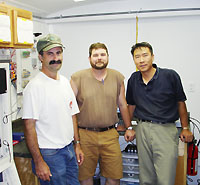ISU/UK Collaborate in First-in-the-Nation Poultry Air Monitoring
ISU/UK Collaborate in First-in-the-Nation Poultry Air Monitoring

Published on October 26, 2005
On Oct. 1, agricultural engineers at Iowa State University and University of Kentucky began collecting air emissions data from two commercial broiler houses in Kentucky. The ISU team traveled to Kentucky to set up the monitoring equipment and train their colleagues. But most days they follow the project on their computer screens in Ames, Iowa.
“This is the first data being collected anywhere in the country under a new national air quality monitoring program,” said Robert Burns, the project leader and associate professor of agricultural and biosystems engineering at Iowa State. “Monitoring at other locations will get under way in 2006, but we’re setting the stage for future poultry and other livestock production facility air emissions monitoring under this program.”
A new air compliance agreement between the Environmental Protection Agency (EPA) and industry groups led to the development of a monitoring project that will gather emissions data from swine farms and manure storage facilities, poultry houses and free-stall dairy facilities across the country.
The $1 million project in Kentucky, funded by Tyson Foods, originally was designed to monitor just ammonia. But the EPA agreed Iowa State could expand the project to include other items of interest — carbon dioxide, three types of particulate matter, hydrogen sulfide and non-methane hydrocarbons.
Hongwei Xin, professor of agricultural and biosystems engineering at Iowa State, is co-leader of the project.
“Monitoring broiler housing air emissions is the most challenging of any mechanically ventilated animal confinement because of the way the exhaust fans must operate,” Xin said. “Broilers go from day-old chicks to six-pound chickens, all in one building. When the birds are small, fans are set on a timer. As they grow larger, the fans cycle on and off based on temperature.”
Burns said air emissions are a combination of concentration and airflow rate.
“We needed to develop a set of instruments and apparatus that could capture and measure a number of factors quickly,” he said. “You don’t buy this sort of thing off the shelf.”
Burns, Xin and several research assistants and students designed and built two mobile air emissions monitoring units for the project. One of Xin’s graduate students, Hong Li, wrote software to run the equipment and data collection system. The mobile labs filled with state-of-the-art instruments now are positioned beside two mechanically ventilated commercial broiler production facilities in western Kentucky. Each building houses about 26,000 birds.
Using continuous, high-speed satellite Internet, Burns and Xin can view data from the two mobile labs, such as current temperature, relative humidity, barometric pressure, ammonia and particulate matter concentrations and whether the fans are operating. They also can remotely control the emissions sampling, turning valves on and off from their computers.
The Iowa State researchers work closely with the University of Kentucky for regular onsite assistance. Richard Gates, professor and chair of the biosystems and agricultural engineering department, is the UK point person.
“We have just finished a USDA-funded poultry emission project with Iowa State and Penn State, using lower cost monitoring equipment. So our team was in place and excited about the opportunity to enhance our national baseline emission measurements,” Gates said.
Doug Overhults, UK associate extension professor, and John Earnest Jr., staff engineer, located at the UK Research and Education Center in Princeton, Ky., are responsible for and as-needed site visits to ensure smooth operation of the system. Burns and Xin also plan to visit the two sites between each flock of birds – about every 50 days.
Data will be collected for one year, then analyzed and reported to the EPA. A similar broiler-monitoring project likely will occur in California.
The idea behind the monitoring is to gather baseline information that can be used to evaluate differences in emissions due to geographical region, season of the year, time of day, building design, growth cycle of the animals and building management. Burns said the emissions data will provide a scientific basis for improving the national emissions inventory and establishing realistic air emissions guidelines.
Writer/Editor: Susan Thompson, (515) 294-0705
Laura Skillman 270-365-7541 ext. 278